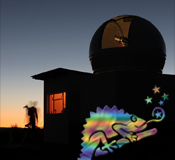 |
CHAMÄLEON + ONJALA OBSERVATORY DeepSky | SITEMAP HOME CHAMÄLEON |
|
 |
|||
| « zurück zur Startseite
galaktische Nebel « back to home galactic nebula |
Großes Bild laden - load large
image 2048 x 1400 Pixel Aufnahmedaten Image data |
RCW 71 - An emission nebula and the red carbon star RX Crux in the coal sack
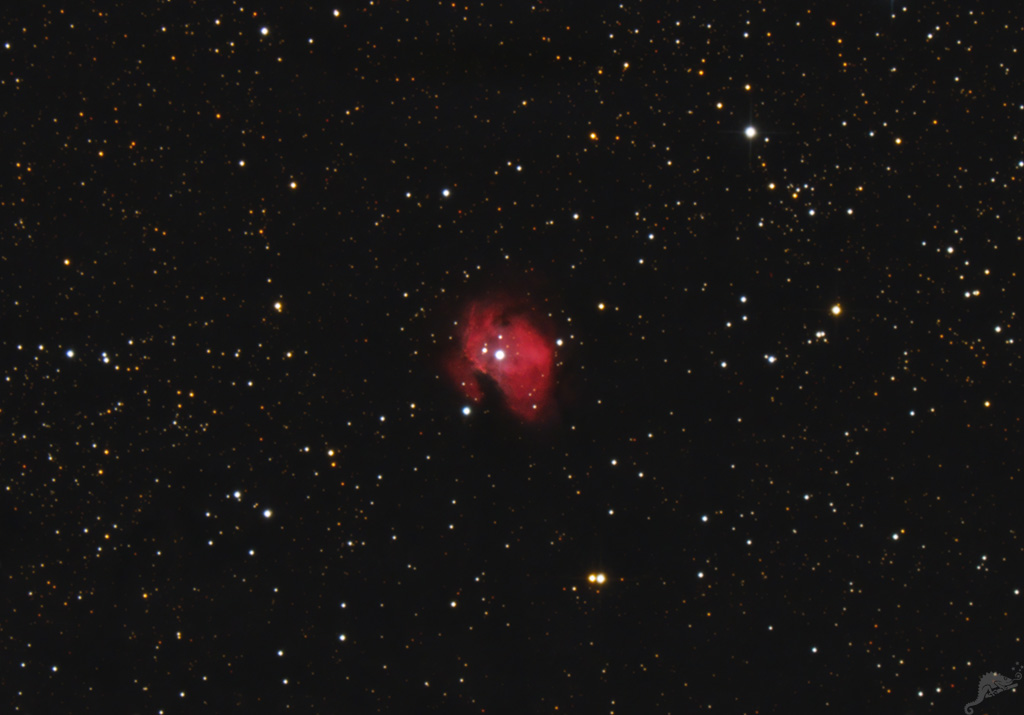
Über RCW 71 - auch als Gum 46 bzw. GN 12.47.3 katalogisiert - gibt es wenig Informationen, denn es ist ein selten gezeigtes DeepSky Objekt Objekt. Es ist eine kleine, mit einem scheinbaren Durchmesser von nur 3 Bogenminuten, H-II Region im Sternbild Kreuz des Südens (direkt südlich von NGC 4755, Herschels Schmuckkästchen) gelegen. RCW 71, mit den Koordinaten (J 2000) RA: 12 h 50m 22s und -61 Grad 35 Minuten und 00 Sekunden, liegt direkt im Kohlensack, der großen Dunkelwolke zwischen den Sternbildern Kreuz des Südens (Crux), dem ihn umgebenden Zentaur (Centaurus) und der Fliege (Musca).
Der die H-II Region ionisierende Stern im Zentrum von RCW 71 ist HD 311 999 mit der Spektralklasse O9.5V. Es ist der hellste Stern eines kleinen Sternhaufens [DBS 2003] + 80, dessen Sterne hauptsächlich Licht im infraroten Spektrum emitieren.
Die Entfernung von RCW 71 wird je nach wissenschaftlichen Untersuchungen auf etwa 5.600 Lichtjahre festgelegt. Da die Entfernung der Dunkelwolke Kohlensack nur etwa 500 bis 600 Lichtjahre beträgt, steht RCW 71 deutlich weiter entfernt und wir blicken somit durch ein transparentes Gebiet der großen Dunkelwolke des Kohlensacks.
Weiterhin zeigt unser Bild einen der seltenen roten Kohlenstoff Sternen RX Crux, mit dem B-V Farbindex von 4.5 Magnituden und der Spektralklasse K. Kohlenstoffsterne (englisch "carbon stars") sind sehr alte Riesensterne, ähnlich roten Riesensternen wie z.B. Antares im Sternbild Skorpion oder Beteigeuze im Orion. Kohlenstoffsterne enthalten im Gegensatz zu den "normalen" Roten Riesensternen mehr Kohlenstoff als Sauerstoff.
Der Kohlenstoff bildet in den äußeren, kühlen Schichten des Sterns verschiedene Kohlenstoffmoleküle, die blaues und gelbes Licht absorbieren und dies führt dazu, dass dem Beobachter der Stern in tiefroter Farbe erscheint. RX Crux liegt mit einer Entfernung von 4.200 Lichtjahren etwas näher zum Sonnensystem als RCW 71.
Kohlenstoffsterne werden in 5 Klassen unterteilt und sind wie viele rote Riesensterne veränderlich. RX Crux ist mit einer Periode von einer Größenklasse irregulär veränderlich. Weitere Informationen zu Kohlenstoff Sternen finden Sie hier.
Object description
There is little information about RCW 71 - also cataloged as Gum 46 or GN 12.47.3 - because it is a rarely shown DeepSky object object. It is a small, with an apparent diameter of only 3 arcminutes, H-II region located in the Southern Cross constellation (just south of NGC 4755, Herschel's jewel box). RCW 71, with coordinates (J 2000) RA: 12 h 50m 22s and -61 degrees 35 minutes and 00 seconds, lies directly in the Coal Sack, the large dark cloud between the constellations Southern Cross (Crux), Centaur (Centaurus) surrounding it, and the Fly (Musca).Translated with www.DeepL.com/Translator (free version)
The star ionizing the H-II region at the center of RCW 71 is HD 311 999 with spectral class O9.5V. It is the brightest star of a small cluster [DBS 2003] + 80 whose stars emit light mainly in the infrared spectrum.
The distance of RCW 71 is determined to be about 5,600 light-years, depending on scientific investigations. Since the distance of the dark cloud Coal Sack is only about 500 to 600 light years, RCW 71 stands much further away and thus we look through a transparent region of the large dark cloud of the Coal Sack.
Furthermore our image shows one of the rare red carbon stars RX Crux, with the B-V color index of 4.5 magnitudes and spectral class K. Carbon stars are very old giant stars, similar to red giant stars like Antares in the constellation Scorpio or Betelgeuse in Orion. Carbon stars contain in contrast to the "normal" red giant stars more carbon than oxygen.
The carbon forms various carbon molecules in the outer, cool layers of the star that absorb blue and yellow light, and this causes the star to appear deep red in color to the observer. RX Crux, at a distance of 4,200 light-years, is slightly closer to the solar system than RCW 71.
Carbon stars are divided into 5 classes and are variable like many red giant stars. RX Crux is irregularly variable with a period of one magnitude. More information about carbon stars can be found here.
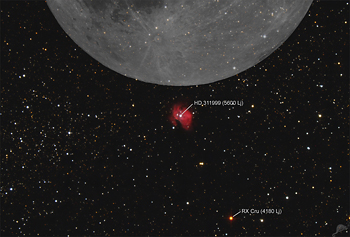 |
Der RCW Katalog (Rodgers, Cambell, and Whiteoak) ist
eine Erweiterung des Gum Katalogs von H-II Regionen des südlichen
Sternenhimmels. Weitere Informationen zu den Katalogen finden Sie
hier. Eine
Weitwinkelansicht von RCW 71
zeigen wir hier. The RCW catalog (Rodgers, Cambell, and Whiteoak) is an extension of the Gum catalog of H-II regions of the southern starry sky. More information on the catalogs can be found here. We show a wide field view of RCW 71 here. « Hier oder auf das Vorschaubild zum Laden eines großen Bildes mit Objektbezeichnungen und Größenvergleich zum Mond klicken « Click here or on the thumbnail to load a large image with object annotations. |
RCW 71 - An emission nebula and the red carbon star RX Crux in the coal sack/southern cross
Image data
03.05.2022 - 35 x 600 s, Alccd 12 (cooled)
Telescope: Planewave CDK 12.5 with Televue 0.8x Reducer at f = 2030 mm
Location: Chamäleon Observatory, Onjala Lodge, Namibia
Image acquisition and processing: Nebulosity, Starnet++, Photoshop
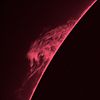 |
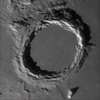 |
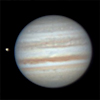 |
 |
 |
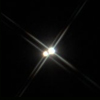 |
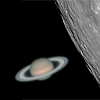 |
| Sonne | Mond | Sonnensystem | DeepSky | Weitwinkel | Verschiedenes | Spez. Projekte |